In one year, turning 10,000 into 1 million through trading cryptocurrencies can only be achieved using this method: rolling positions + investing in promising altcoins!
A method I have personally tested allowed me to turn 10,000 into over 1.8 million in 11 months in 2024, nearly an increase of over 180 times!
If you also want to get a piece of the pie in the cryptocurrency world, then take a few minutes to read this article; you are only one step away from a million!
In 2017, with a try-and-see attitude, I bought my first Bitcoin for 1,000 yuan. At that time, the price of Bitcoin was still hovering around several thousand yuan, and I didn't even expect it to rise much. However, in just a few months, the price of Bitcoin skyrocketed, turning my 1,000 yuan into tens of thousands.
Having tasted success, I began to delve deeper into blockchain and digital currencies, gradually investing in mainstream coins such as Ethereum and Litecoin. I learned to read K-line charts, analyze market trends, and even participated in private placements of some early projects.
In 2018, the cryptocurrency market welcomed a bull market, and my assets soared as well. I seized the opportunity decisively, liquidated some digital currencies, and purchased my first house in the city center.
Of course, the cryptocurrency world is not always smooth sailing. The bear market in 2019 caused me heavy losses, but I did not give up; instead, I chose to continue learning and accumulating knowledge. I firmly believe that blockchain technology is the trend of the future, and the value of digital currencies will eventually return.
In 2020, the rise of DeFi (Decentralized Finance) reignited enthusiasm in the cryptocurrency world. I keenly captured this trend, actively participating in liquidity mining and staking, and gained substantial returns.
Now, I have achieved financial freedom, but I still maintain my love and exploration of blockchain technology. I know that the cryptocurrency world is full of opportunities, but also hides risks. Only by continuously learning and staying rational can one ride the waves in the turbulent sea of cryptocurrencies.
My experience sharing:
Learning is fundamental: Understanding blockchain technology, the principles of digital currencies, and market trends are prerequisites for investing.
Rational investment: Do not blindly follow trends; invest according to your risk tolerance.
Diversified investment: Do not bet all your funds on one project; diversifying your investments can reduce risks.
Long-term holding: The digital currency market is highly volatile, and long-term holding of quality assets is more likely to yield substantial returns.
Stay calm: Do not be influenced by market emotions, and only a calm mind can make correct decisions.
The stories of getting rich quickly in the cryptocurrency world are indeed enviable, but the risks and efforts behind them cannot be ignored.
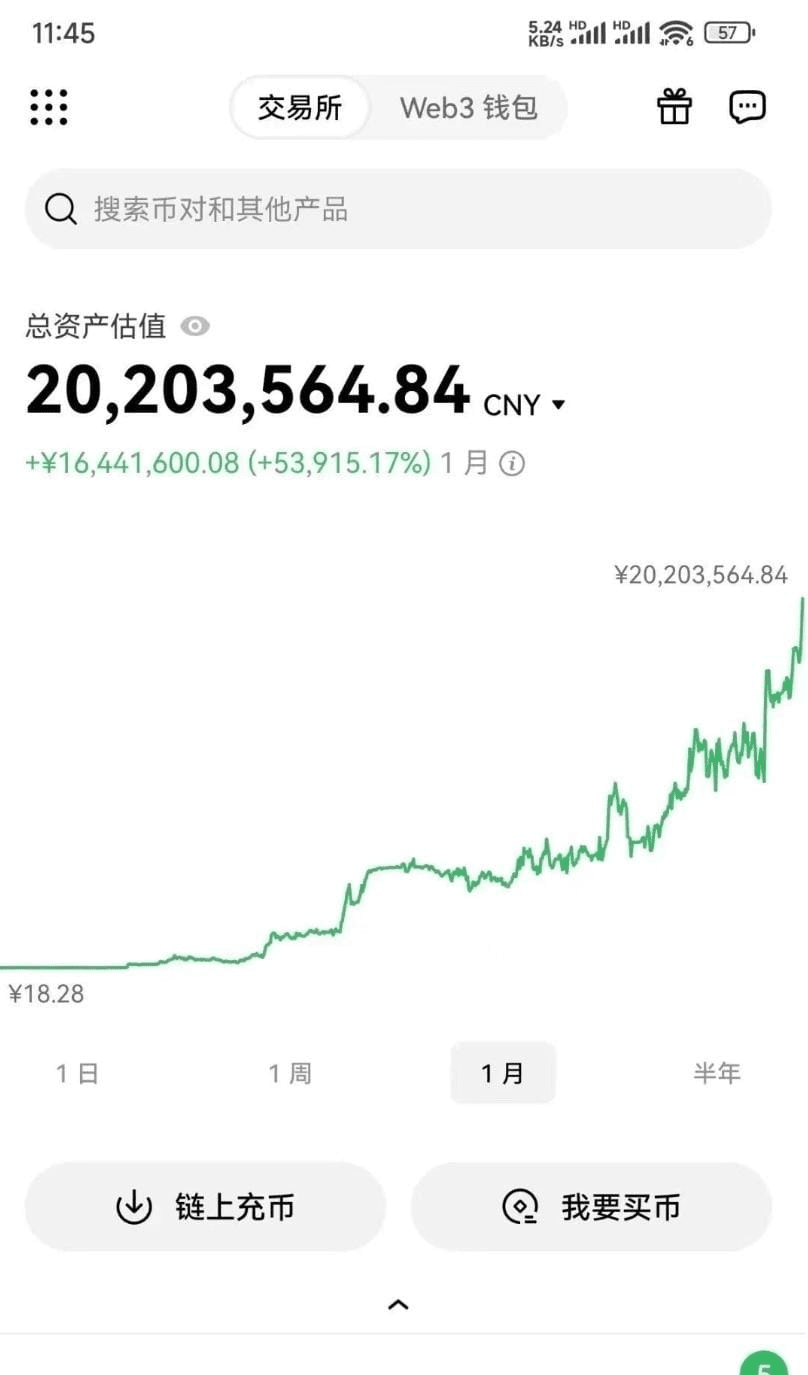
1. MACD is the most commonly used indicator by experts.
The MACD indicator plays a very special role in technical analysis and can be said to be an essential part of learning technical analysis. Its importance can be summarized in the following points.
First, the MACD indicator is one of the most effective technical indicators verified by historical trends and is also the most widely used indicator.
Second, the MACD indicator is derived from the EMA moving average indicator and has a good application effect in grasping trending markets. Trend investors generally refer to this indicator in practice.
Third, the top and bottom divergence of the MACD indicator is recognized as the best method for 'bottom hunting and top escaping,' which is an important tool for concretizing trend theory and wave theory.
Fourth, many veterans have had the experience of starting to learn the MACD indicator when they first entered the field, but then slowly abandoning it. After a long period of learning and comparison, especially after practical verification, they eventually returned to the MACD indicator. This shows the indicator's particularity.
Fifth, the application of the MACD indicator in quantitative trading is also extremely widespread.
It is because of these advantages that the MACD indicator has become the most commonly used technical indicator by professional traders.
Two, the concept and algorithm of the MACD indicator.
The MACD indicator, also known as the Exponential Moving Average Convergence Divergence (MACD), was created by Gerald Appel and is used to track price trends and analyze K-line buying and selling timing. This indicator is commonly used in trading software and is known as the 'king of indicators.' As shown in [Figure 1].
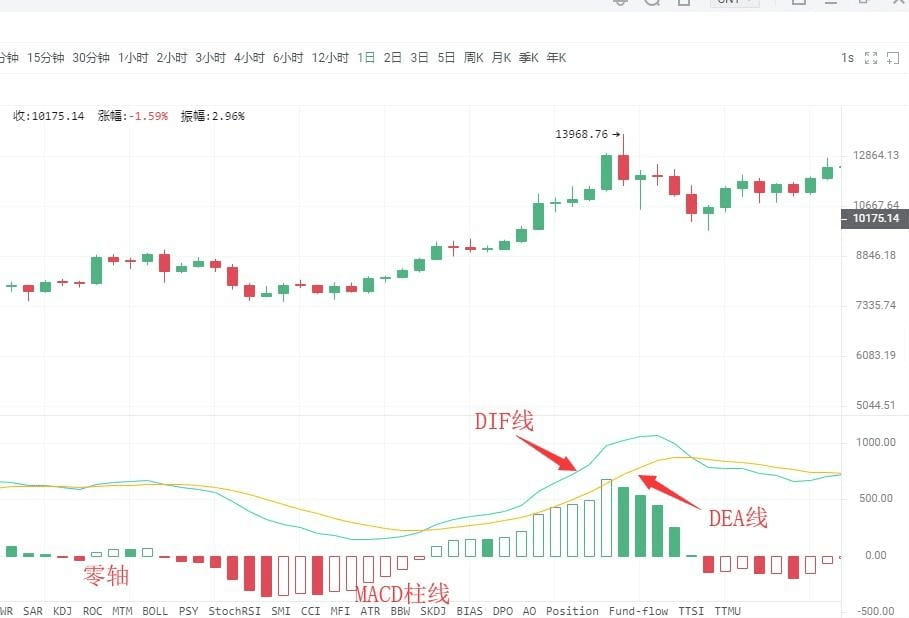
The MACD indicator in the cryptocurrency world consists of the DIF fast line, DEA slow line, MACD histogram, and zero line, collectively referred to as the 'three lines and one axis.' Investors analyze price through the crossings, divergences, breakthroughs, supports, and resistances of these 'three lines and one axis.' The MACD indicator has become a preferred indicator in many trading software, indicating its wide application, which also indirectly shows that this indicator is one of the most effective and practical indicators verified by history.
Three, the golden cross and dead cross of MACD
The 'golden cross' and 'dead cross' patterns are extremely important forms in technical indicator analysis. The golden cross pattern can also be called a golden cross, which refers to the shorter-period indicator line crossing upwards through the longer-period indicator line (of the same type), often indicating the emergence of a short-term buying opportunity. If the golden cross occurs after ①. a short-term rapid decline during a downward trend; ②. a wave of correction during an upward trend; ③. a consolidation during an upward trend, that is, when the golden cross appears at a stage low, it is a more reliable buying signal.
The dead cross pattern can also be called a death cross, which occurs when the shorter-period indicator line crosses downwards through the longer-period indicator line (of the same type), often indicating the emergence of a short-term selling opportunity. If a dead cross pattern appears after ①. a consolidation during a downward trend; ②. a wave of rebound during an upward trend; ③. a short-term rapid rise during an upward trend, when the dead cross pattern appears at a stage high, it is a more reliable sell signal.
After understanding the golden cross and dead cross patterns, we can look specifically at the golden cross and dead cross patterns of the MACD indicator line. The golden cross and dead cross occurring in different positions will reflect different market meanings.
Situation One: Buying point of low-position golden cross
The position of the golden cross between the DIFF line and DEA line, if it occurs below the zero line and is far from the zero line, is called a low-position golden cross. Investors can view this golden cross merely as a short-term price rebound, and whether the K-line can form a real reversal still needs to be observed and confirmed in conjunction with other indicators.
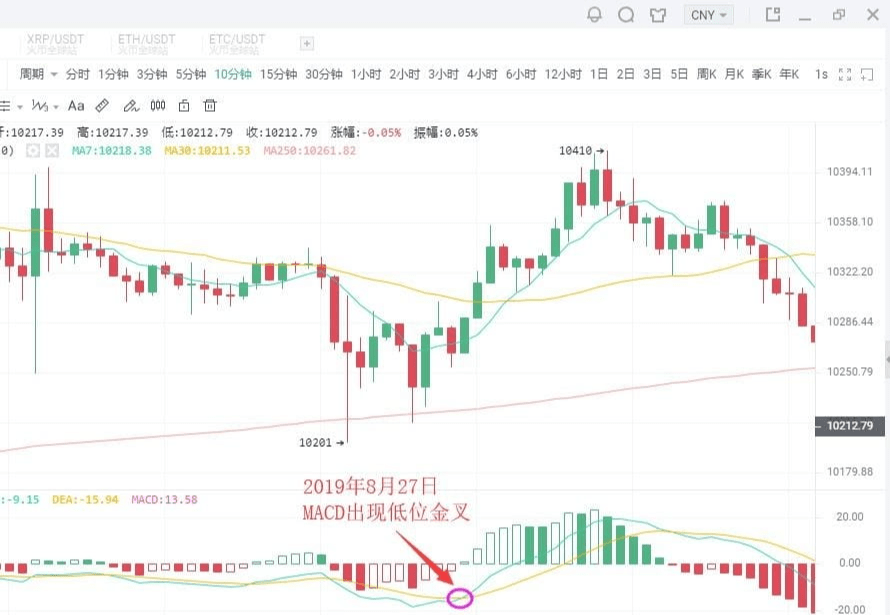
As shown in the figure above:
On August 27, 2019, the BTC 10-minute K-line chart showed that with the price correction, a low-position golden cross appeared, followed by a rebound of $200, allowing short-term investors to grasp the opportunity to enter the market.
Situation Two: Buying point of golden cross near the zero line
If an upward trend has been formed and the golden cross of the DIFF line and DEA line occurs near the zero line, then it is often an excellent buying opportunity for investors.
This is because, after an upward trend is formed, a golden cross near the zero line indicates that the adjustment has been completely finished, and a new round of upward trend has started. If this comes with a golden cross in the volume line, it indicates that the price rise is supported by transaction volume, making the buy signal more reliable.
Once this buying point appears, investors absolutely should not miss it, or else they will miss a significant upward trend.
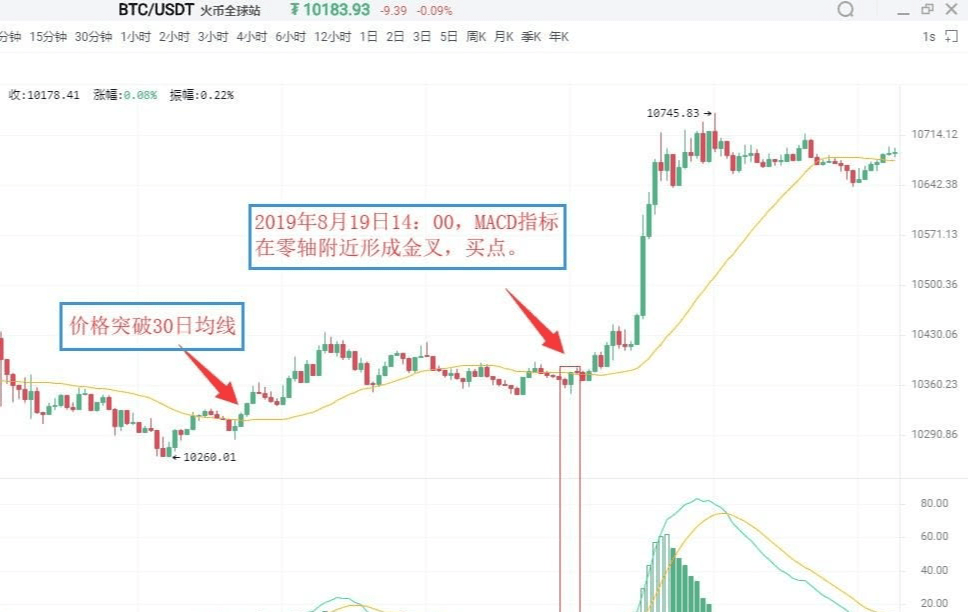
As shown in the figure above:
On August 19, 2019, at 09:30, the BTC 5-minute K-line chart showed that Bitcoin broke above the 30-day moving average, indicating that an upward trend had begun to form. For a period afterward, the price consistently operated above the 30-day moving average.
On August 19, 2019, at 14:00, the MACD indicator formed a golden cross near the zero line, indicating that the market is about to experience a significant upward trend. Investors can buy decisively.
Situation Three: Buying point of high position golden cross
If the golden cross between the DIFF line and DEA line occurs above the zero line and is in a region far from the zero line, this golden cross is called a high-position golden cross. High-position golden crosses generally occur during the consolidation phase in the upward price movement, indicating that the consolidation has ended and the K-line is about to continue the previous upward trend. Therefore, when a high-position golden cross appears, it is a good signal to increase positions.
In practice, when an upward trend forms and the K-line rises slowly and lasts for a long time, once the MACD indicator forms a high-position golden cross, it often indicates that the K-line is about to experience accelerated upward movement.
Because of this, the high-position golden cross can also be used for swing trading. Investors can use the MACD indicator to target upward swings continuously during an upward trend.
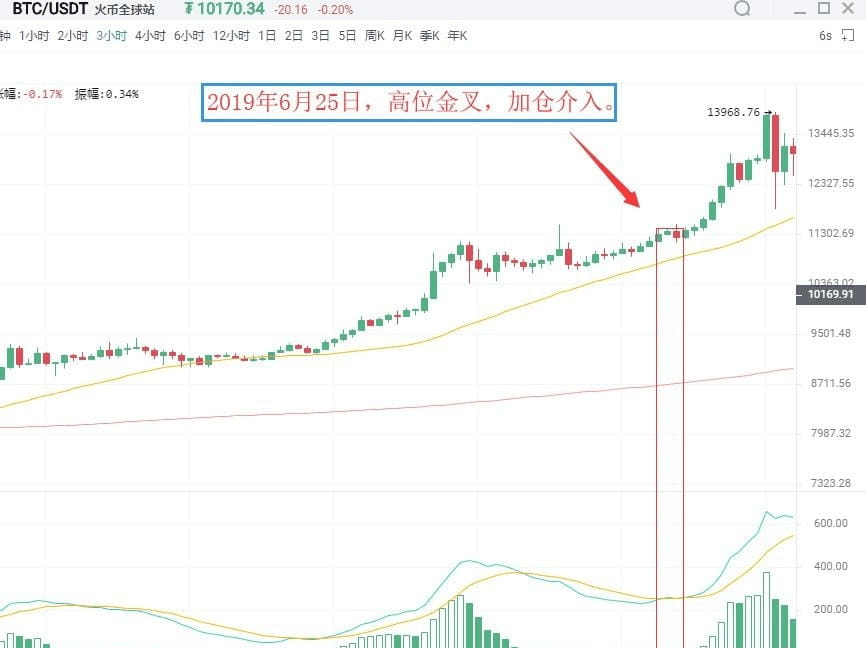
As shown in the figure above:
On June 25, 2019, the BTC 3-hour K-line chart showed that while Bitcoin's price was on an upward trend, after some consolidation, it rose again, and the MACD indicator showed a high-position golden cross. This indicates that the pullback has ended, and the price will continue the previous upward trend. Investors should pay attention to seizing this opportunity to increase their positions.
Situation Four: Sell point of low position dead cross
The low-position dead cross occurs at a point significantly below the zero line. This type of low-position dead cross often appears at the end of a rebound during a downward trend, making it a sell signal indicating the end of the rebound. At this point, investors who are not participating in the market should observe, while those deeply trapped in positions can sell first and buy back later after a price drop to reduce costs.
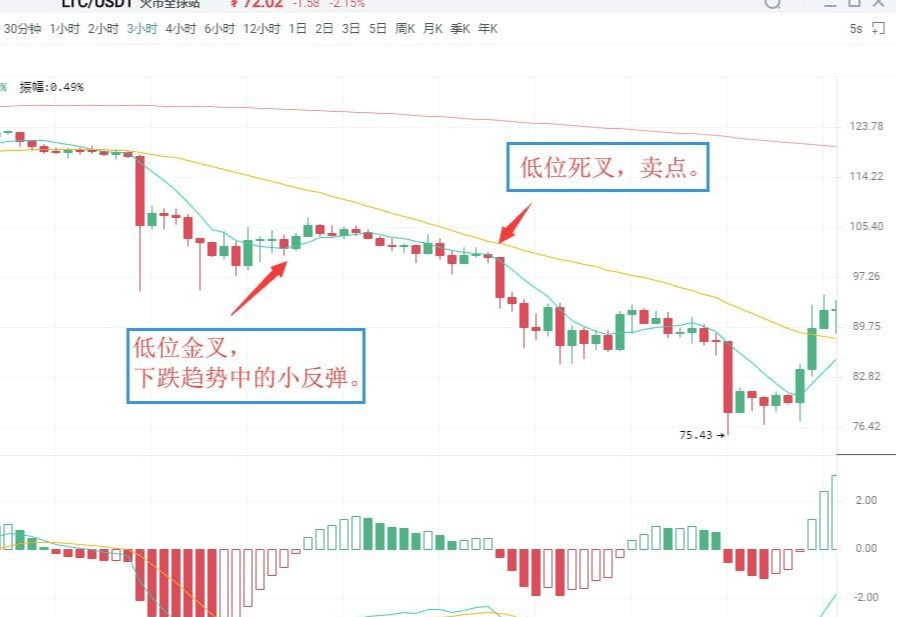
As shown in the figure above:
On July 14, 2019, the LTC 3-hour K-line chart showed that the MACD indicator formed a low-position golden cross, and the price experienced a slight rebound before quickly declining.
Immediately following, the MACD indicator formed a dead cross below the zero line, after which the K-line began a new round of downward movement. Spot investors can sell positions at the dead cross point and later buy back to reduce holding costs.
Situation Five: Sell point of dead cross near the zero line
If the previous market direction has been a downward trend, the crossing of the DIFF line breaking the DEA line near the zero line is called a dead cross near the zero line, indicating that the market has accumulated considerable downward momentum near the zero line. When a dead cross appears, it signifies the release of downward momentum, and the K-line will continue the original downward trend, serving as a sell signal.
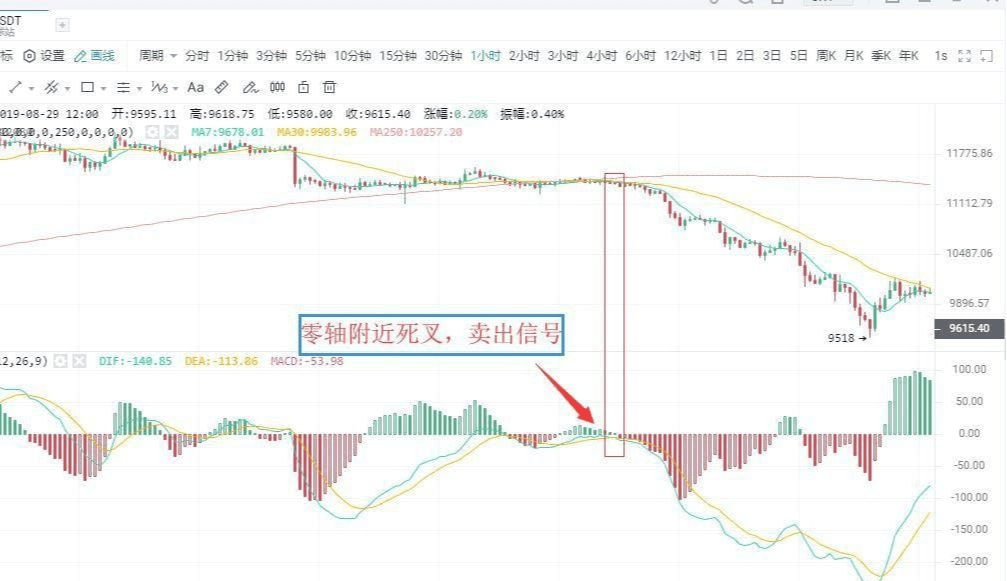
As shown in the figure above:
On August 12, 2019, the BTC 1-hour K-line chart showed that the DIFF line broke below the DEA line to form a dead cross near the zero line. It indicates that the market's downward momentum is beginning to release, serving as a sell signal, and investors should sell decisively; otherwise, they will be deeply trapped.
Situation Six: Sell point of high position dead cross
The DIFF line breaking below the DEA line at a point significantly above the zero line is called a high-position dead cross. This type of death cross pattern is sometimes accompanied by a top divergence in the MACD. It manifests as: during a sustained upward trend, the price continuously hits new highs, but the MACD indicator's DIF and DEA lines no longer continue to rise or push higher, instead forming a divergence with the price's upward trend and gradually declining.
Above the zero line, when the DIF line crosses downwards through the DEA line, it forms a downward cross pattern, which is a relatively reliable sell signal.
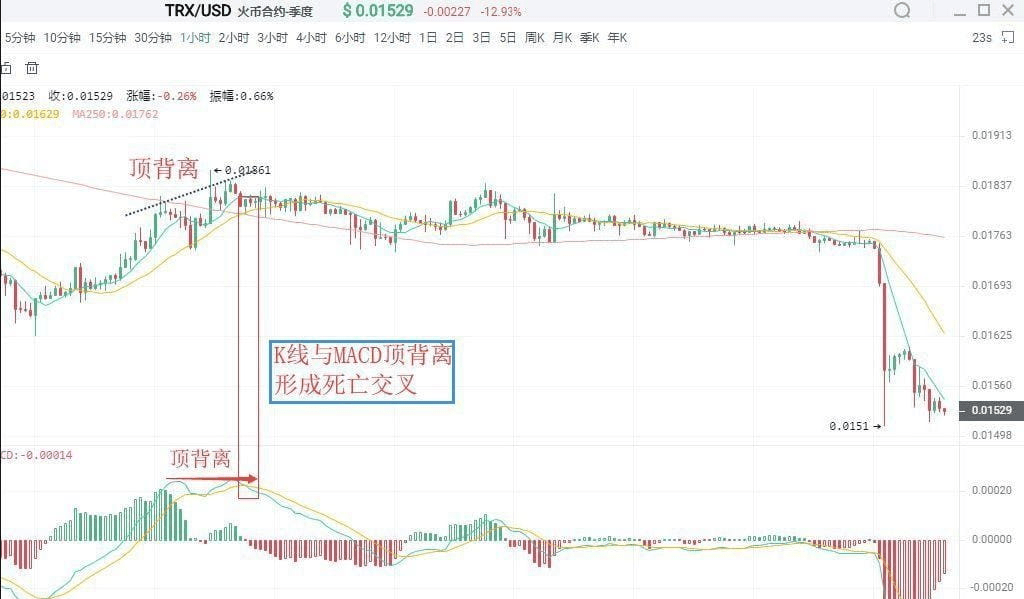
As shown in the figure above:
On August 23, 2019, the TRX 1-hour K-line chart showed that after a wave of increase in the price of TRON, it reached a new high, but the DIF line and DEA line no longer continued to rise, followed by a death cross and a sell signal.
Four, Divergence between MACD and K-line
Divergence is a term in physics that describes momentum; in technical analysis, it is a widely applicable analysis method with a high success rate. In a downward trend, when the price hits a new low while the indicator line does not create a new low, it is called bottom divergence, indicating that upward momentum is accumulating and is a buying signal. In an upward trend, when the price hits a new high while the indicator line does not create a new high, it is called top divergence, indicating that downward momentum is accumulating and is a selling signal.
Ⅰ. Bottom divergence
(1) Bottom divergence of MACD histogram and DIFF line
The bottom divergence between the DIFF line and the price refers to when, during a downward trend, the price hits a new low while the DIFF line does not create a new low. It indicates that during the price decline, the decline of the DIFF line is less than that of the price, suggesting that upward momentum is accumulating, and the price is likely to stop falling, with a higher probability of rising in the next period.
The MACD histogram is the MACD bar hidden behind the DIFF line, divided into red and green. Its divergence from the price is an important application of the MACD indicator, widely used in practice. The bottom divergence between the MACD histogram and price refers to when the price continuously hits new lows, while the MACD histogram does not create new lows. It indicates that upward momentum is accumulating, and there is a high probability that the price will stop falling and rise in the following period.
When bottom divergence occurs, investors can grasp specific buy points through two methods.
(2) Specific buying timing
The bottom divergence of the DIFF line, MACD histogram, and price is not a specific point in time but a pattern that appears over a period. However, the specific buying time for investors is a specific point in time, indicating that the price is about to stop falling. Therefore, to grasp the specific buying timing, when the DIFF line, MACD histogram, and K-line show bottom divergence, investors must combine this bottom divergence with other technical analysis tools to specify the buy point.
First: Histogram color change or MACD golden cross.
The color change of the histogram indicates that the market's upward momentum has begun to dominate. It generally appears after the 'histogram shortens,' although it may be a little late, it is more reliable. When bottom divergence appears, if the histogram successfully changes color or forms a golden cross, investors can buy.
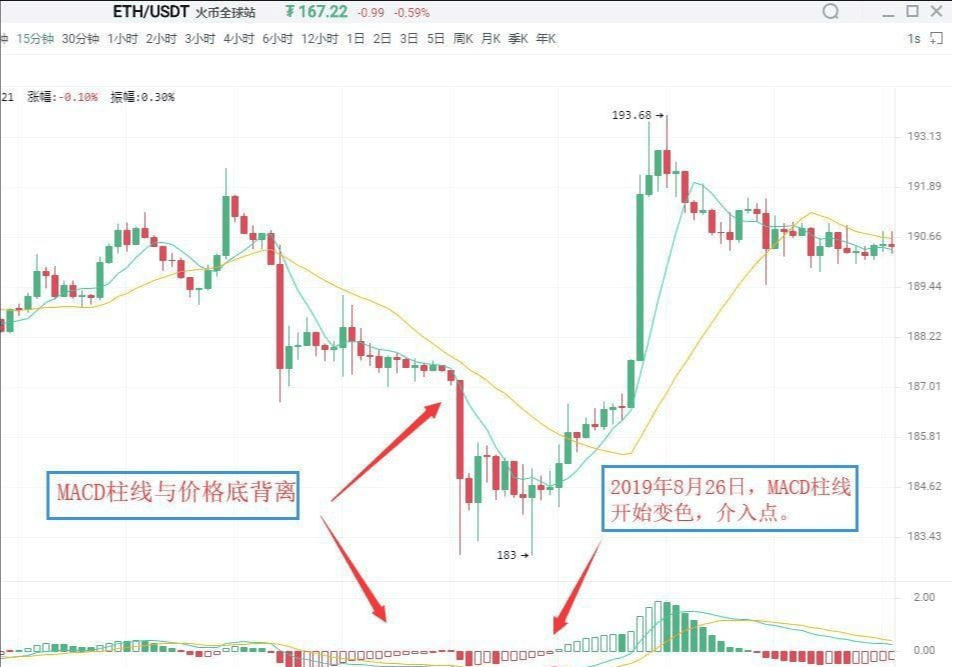
As shown in the figure above:
On August 26, 2019, the Ethereum (ETH) 15-minute K-line chart showed that while Ethereum's price hit a new low during a decline, the MACD histogram did not create a new low, forming a bottom divergence between the histogram and the price. It indicates that upward momentum is beginning to accumulate, and there is a significant possibility that the price will experience a wave of upward movement.
Immediately following the color change of the histogram, the two sequential buy signals combined increase the reliability of the upward significance, allowing investors to intervene when the histogram changes color.
Second: Combine with other technical analysis tools and K-line reversal patterns.
Combining bottom divergence with K-line reversal patterns, such as 'single needle probing the bottom' and 'bottom three soldiers,' is a concrete application of the 'multi-indicator combination' principle.
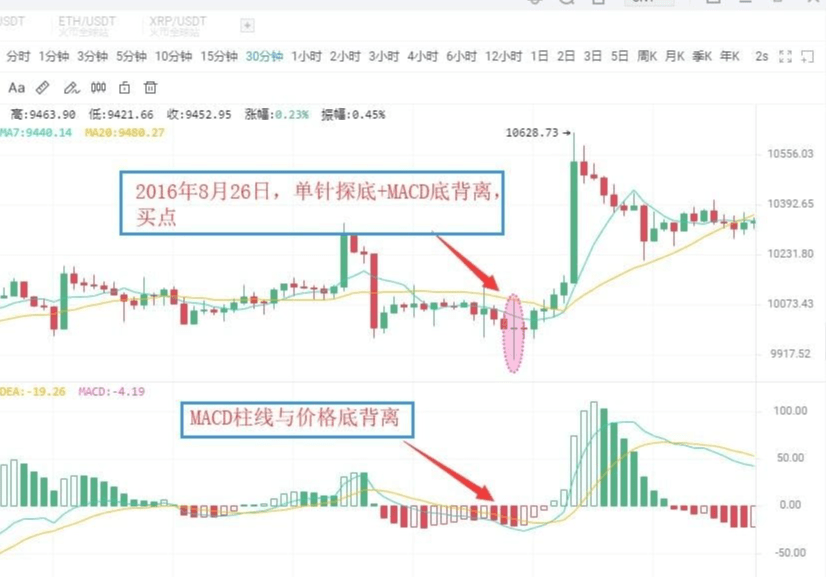
As shown in the figure above:
On August 26, 2016, the BTC 30-minute K-line chart showed that while the price of Bitcoin hit a new low, the MACD histogram did not create a new low, forming a bottom divergence between the histogram and the price, indicating that the market's upward momentum is continuously strengthening.
Accompanied by the price's downward probe and stabilization, a buy signal of 'MACD histogram and price bottom divergence + K-line single needle probing the bottom' is formed. Subsequently, the price shows a wave of upward movement.
Ⅱ. Top divergence
(1) Top divergence of MACD histogram and DIFF line
The top divergence between the MACD histogram and the K-line refers to when, in an upward trend, the price hits a new high while the MACD histogram does not create a new high. It indicates that the market's downward momentum is accumulating, and the price may drop at any time.
The top divergence between the DIFF line and K-line refers to when, in an upward trend, the price hits a new high while the DIFF line does not create a new high. This indicates that downward momentum is continuously accumulating in the market, and there is a significant possibility that the price may experience a wave of downward movement.
(2) Specific selling timing
Similar to bottom divergence, in practice, investors can use the principle of combining multiple indicators to make sell signals more specific.
First: Histogram color change or MACD dead cross.
After the top divergence between the MACD histogram and the K-line forms, if the histogram suddenly shortens significantly, it indicates that the market's downward momentum is beginning to release. Investors should pay attention to selling in a timely manner. A color change in the MACD histogram indicates that the market's downward momentum has taken the lead, which generally appears after the histogram continues to shrink. If the histogram changes color or a MACD dead cross occurs after a top divergence with the K-line, investors should pay attention to exit in a timely manner.
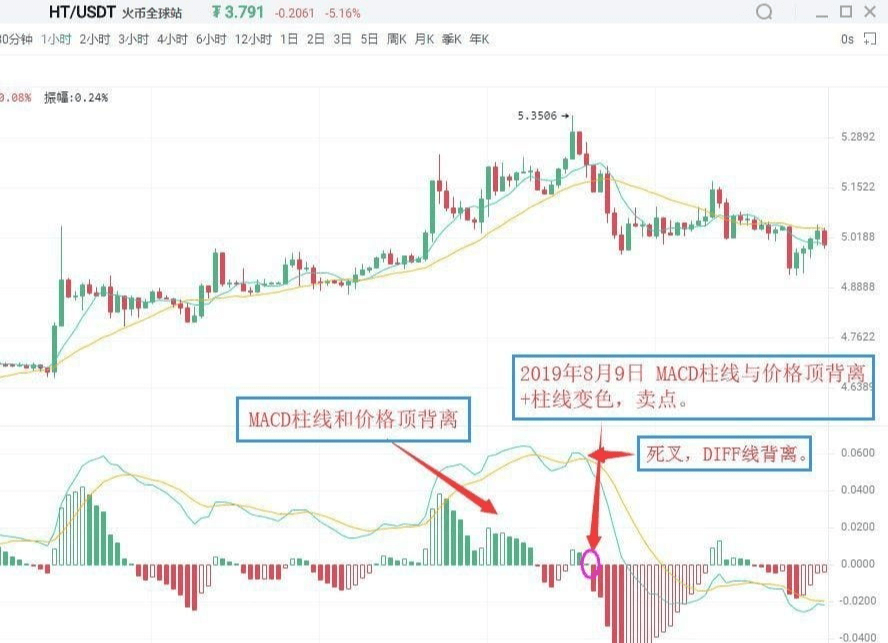
As shown in the figure above:
On August 9, 2019, the HT 1-hour K-line chart showed that while Huobi's price reached a new high, the MACD histogram did not create a new high, forming a top divergence between the histogram and the price. This indicates that downward momentum is continuously accumulating, and the price may drop at any time.
Subsequently, the MACD histogram changed from red to green, issuing a sell signal of 'histogram and price top divergence + histogram color change.' Investors should pay attention to exit in a timely manner.
Second: Combine with other technical analysis tools and K-line reversal patterns.
After the top divergence between the MACD histogram and the price occurs, if other technical analysis tools also simultaneously show sell signals, the reliability of the market's sell meaning will greatly increase, and at this point, investors should pay attention to exiting decisively. Common sell signals in this category include 'histogram and price top divergence + K-line reversal patterns,' etc.
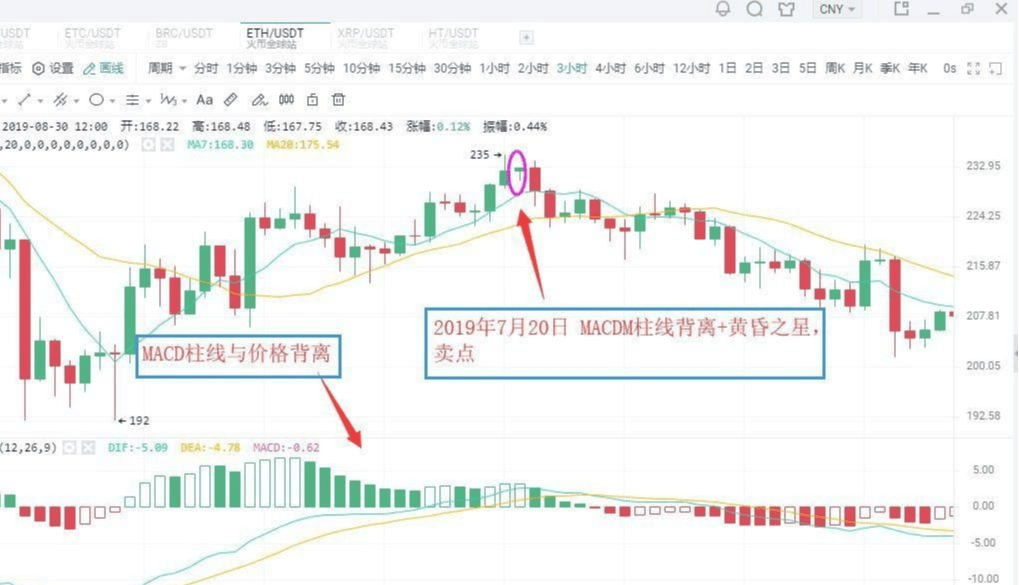
As shown in the figure above:
On July 20, 2019, the ETH 3-hour K-line chart showed that Ethereum's price reached a new high, but the MACD histogram did not create a new high, forming a top divergence between the histogram and the price. This indicates that the market's downward momentum is continuously strengthening, and the price may experience a wave of downward movement.
Subsequently, the MACD histogram gradually shortened, while the K-line formed a bearish evening star pattern. Investors should pay attention to exit in a timely manner, and afterward, the K-line showed a significant downward trend.
Appendix:
Evening Star: During a rising process, a long bullish line first appears, followed by a shorter candlestick (either bullish or bearish) on the next day, which people liken to a star; this is the main part of the candlestick combination. The third candlestick is a long bearish line, which has deeply penetrated the body of the first candlestick. The evening star signals a price peak and subsequent decline, with some predicting an accuracy rate of over 80%.
(Regarding some K-line patterns that indicate peaks and troughs, we will have a few dedicated courses to explain in depth later, so stay tuned!)
Five, Modifying MACD parameters
The lag in price response can sometimes lead to less than ideal buying and selling levels, which is a defect of the MACD indicator. One way to change this situation is to adjust the indicator parameters to make the MACD indicator respond more sensitively to trends, thereby allowing for more ideal buying and selling price levels.
In commonly used trading software, the default parameters of the MACD indicator are 12/26/9. Under this parameter setting, the MACD indicator often responds to price changes with considerable lag.
The lag of the MACD indicator can be addressed by adjusting its parameters. Commonly used parameter combinations include 5/34/5, 5/10/30, etc. Investors can also try and explore more in practice.
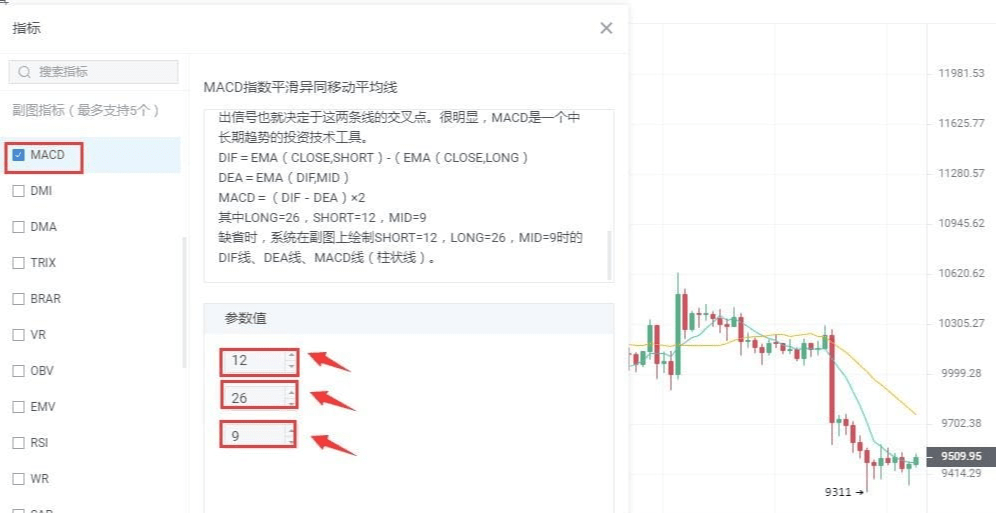
Daily performance

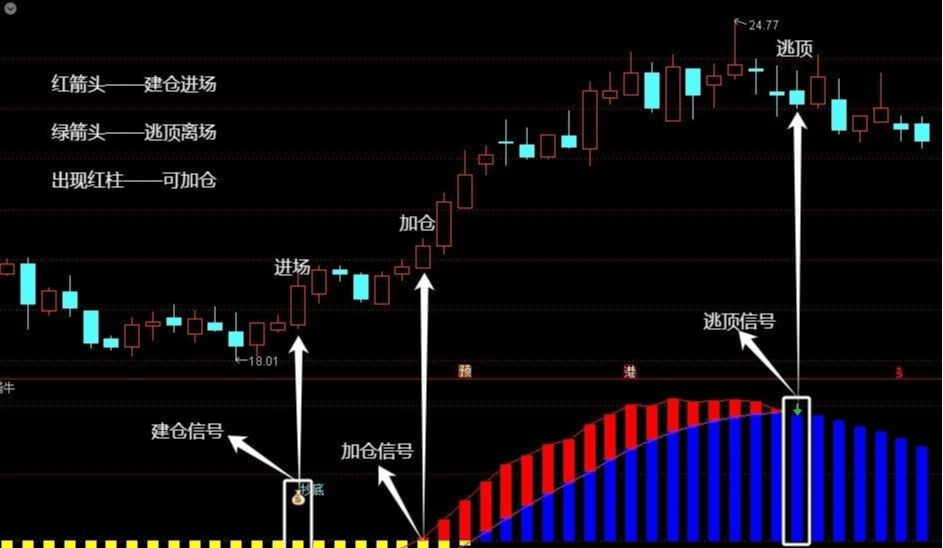
[MACD Bottom Hunting and Bull Capturing] Key points are as follows:
1. The yellow histogram below the zero line represents bearish volume. When the green histogram on top of the yellow histogram disappears and red arrows and money bag icons appear, this is a building position signal, indicating that buying can be considered.
2. When the indicator shows a red histogram above the zero line, it indicates that the bullish forces are starting to strengthen, and the market trend is shifting from weak to strong. At this point, investors can consider increasing their positions to obtain greater profits.
3. The blue histogram above the zero line represents bullish volume. When the red histogram on top of the blue histogram disappears and a green arrow appears, this is an escape signal, indicating that one should consider selling to avoid losses caused by market corrections.
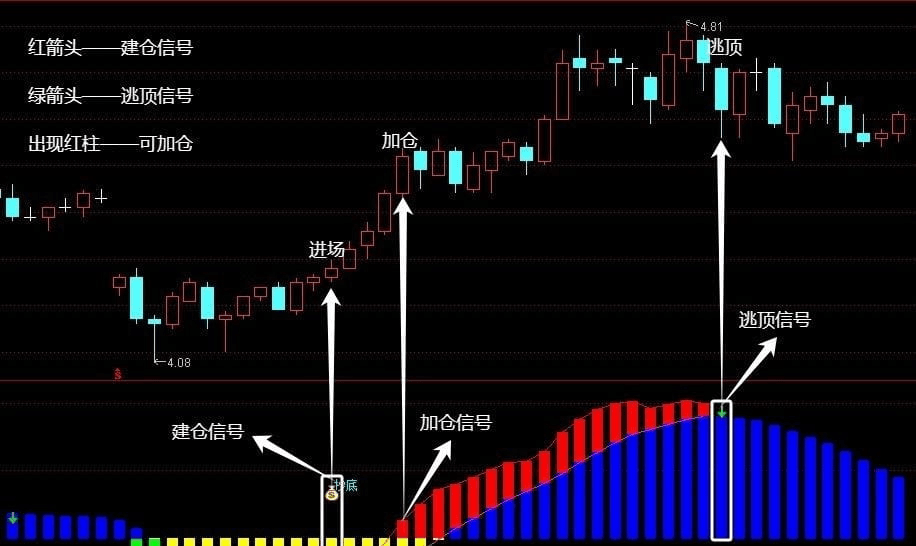
I wrote an article about the mindset of trading cryptocurrencies, hoping to become a beacon for you on your cryptocurrency journey in 2025, so you will never lose your way!
Let’s summarize a few reasons for losing money; only by knowing why you lost money can you understand where you can make money.
1. Not stopping losses; turning short-term into medium-term, and medium-term into long-term.
As a long-time investment practitioner, I am often asked, 'What is the most common mistake investors make in the investment market?' My answer is not having immediate and rapid stop losses. Due to the leverage effect of long and short dual-direction investments, both profits and losses get magnified. The consequences of not stopping losses in a timely manner are often extremely severe. The same goes for the cryptocurrency market. We all know that in the cryptocurrency market, our most valuable asset is our investment capital, which is like ammunition on the battlefield; without it, failure is inevitable. We must always pay attention to protecting our capital and not let losses expand indefinitely. Many people hope, pray, and dream of finding a perfect trading method that can yield complete profits without needing to stop losses. In a nutshell, regardless of the field, such a perfect money-making method is impossible. Successful trading methods, like successful lives, are not achieved by avoiding losses but are determined by controlling the quality of losses.
Switching time frames is also a common mistake made by novice traders in the cryptocurrency market. The so-called switching time frames is a disguised form of not stopping losses and not admitting mistakes. It happens like this: a trader buys a contract intending to achieve good short-term returns, but the market trend does not produce the desired effect. This investor does not sell within the short-term time frame but decides to hold this contract and switch to medium or long-term investment. This is just an excuse to avoid stopping losses. This method of switching time frames will inevitably lead to disaster, and stopping losses is the only way to prevent disasters.
2. Not paying attention to capital management, lacking control over positions.
We use our hard-earned money to participate in cryptocurrency trading, which is not fundamentally different from investing in a convenience store near your home. If the small owner of the convenience store comes to you for some money for his little shop, how would you consider whether to invest or not? How much would you invest? Would you decide like that without thinking, as you do in cryptocurrency trading? So-called capital management aims to solve the problems of whether to invest and how much to invest.
The suggestion for newcomers is to divide their capital into six portions, investing only one portion each time. As their experience gradually increases and their investment accuracy improves, they can slowly increase their positions, but at no time should their holdings of a single asset exceed fifty percent of their total capital. Otherwise, if an error occurs, it will be very difficult to recover. For example, if you have 100,000 yuan and lose 50% in one go, you are left with 50,000 yuan. To earn back 100,000 yuan from 50,000 yuan, you need to double your investment, which is a much longer process. Anyone with a basic understanding of mathematics knows that doubling from 50% is a longer journey than recovering from 50%.
In the capital management community in the United States, a survey was conducted: the most important factor for long-term winning funds is not when and at what price they enter the market, but how much the fund has bought. This is the term commonly mentioned in the investment community: capital management. If you do not pay attention to capital management methods in cryptocurrency trading, you will never reap the final victory.
Personal experience summary:
1. Plan your capital reasonably for cryptocurrency trading, ensuring that you have food in hand and are not anxious!
2. Do not make emotional trades; do not be blinded by profits, and avoid making blind orders.
3. Develop a good trading plan and follow the market.
Large positions for trends, small positions for swings, control your own ratio well. Trade lightly against the trend with stop loss, and add positions with strict defense when trading with the trend. There is no way to lose money in trading cryptocurrencies, only ineffective operations that do not make money. Trading cryptocurrencies is a test of the right mindset! I wish all my friends trading cryptocurrencies can find their own trading methods and make steady profits.
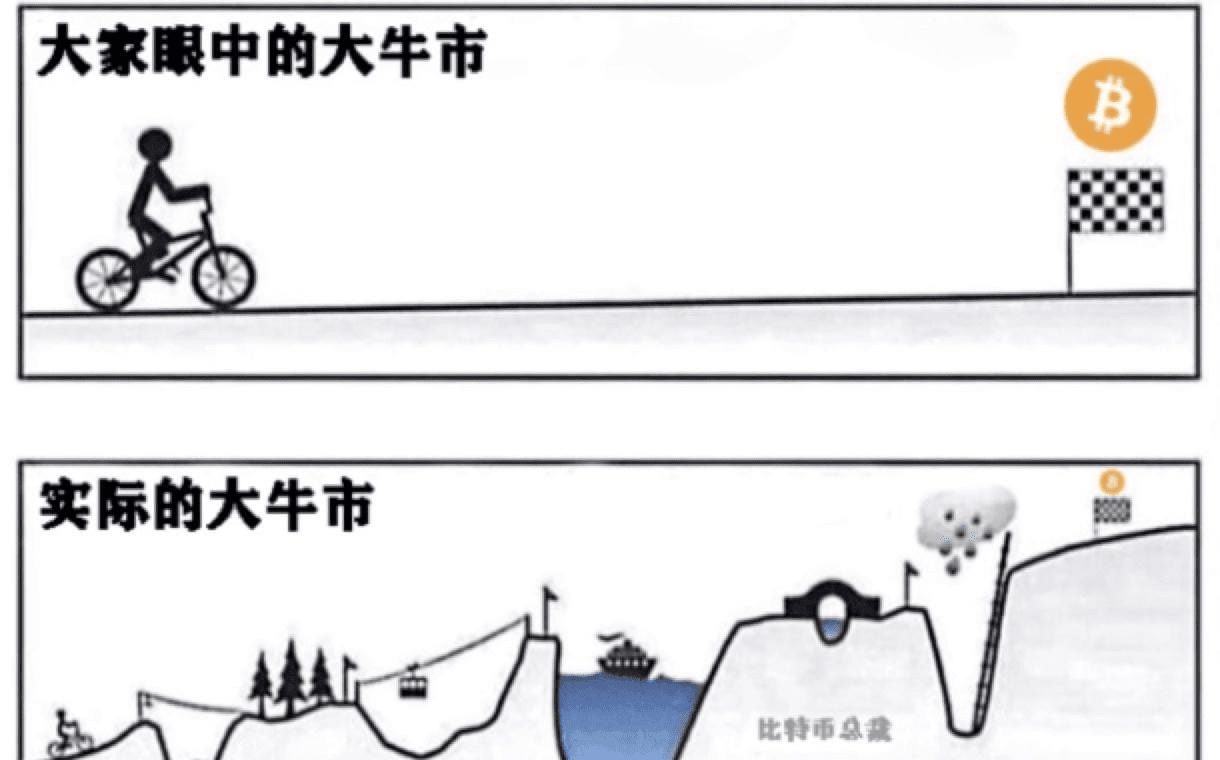
From tens of thousands to tens of millions! The following three points must be mastered ✅
Continuing to discuss: If you achieve these three points in the cryptocurrency world, it will be difficult to lose money again in the future!
First point: Do not look at market comments after placing an order.
There are always two voices in the market: one tells you the market will fall; the other tells you the market will rise. There is never a day when the market uniformly predicts a rise or fall. Because if that were the case, there would only be one type of person in the market, all making money or all losing money, which does not conform to market laws. Therefore, after placing an order, do not think about how others comment on the market's rise or fall, as such conflicting opinions will shake your basis for making a decision, leaving you uncertain whether to hold or exit early. Perhaps seeing opinions that align with yours will give you confidence, and you will think you will make a lot of money, but when the directions are inconsistent, you may feel particularly anxious, leading to incorrect judgments and decisions!
True investors, upon capturing trading signals, do not pay attention to market changes, but strictly follow their trading plan to complete the trade!
Second point: Do not place an order and then lock in losses without stop-loss.
Everyone knows that investing carries risks, and nothing is 100% certain, so it is crucial to establish strict stop-loss measures when placing orders. Stopping losses requires great courage; many people refuse to admit defeat, believing their direction is correct. However, admitting defeat will directly result in significant losses. The market will never show you any sympathy; after making a wrong decision, you should immediately protect your principal. What’s even more troublesome is locking in positions; many people have experienced it: locking in a position, then unlocking it, only to find it drops, making them afraid to short because they worry it won't rise again, or it rises and they are afraid to go long, wondering what to do if it keeps rising. Locking in positions is not just a monetary loss; it is also a tremendous psychological pressure and suffering.
Third point: Do not easily increase positions after placing an order.
Many people like to keep increasing their positions and rush forward with their trades. Remember not to increase positions after the direction turns against you; wait for the next opportunity to build positions. If you keep increasing positions, stop-loss levels will inevitably move, and moving stop-loss levels will only lead to more significant losses. Some may say that after hitting the stop-loss, the currency's trend moves in the desired direction; however, everyone needs to be patient and wait for the right point to build positions. Generally, hitting such a stop-loss makes people feel very unfair and frustrated. But have you ever considered that such stop-losses are usually due to not grasping the right entry point or improper stop-loss settings? Of course, if your trading plan is very thorough, appropriate position increases are feasible. However, when discovering that your trading plan has gone awry, you must strictly stop-loss and exit.
Successful investors do not rely on luck; only by respecting the market, fearing the market, and following the market while strictly adhering to trading discipline can one survive. Trading should not be based on one-sided wishes. We must firmly grasp the opportunity to lose less and win more, and abandon the mindset of gains and losses, in order to remain undefeated in the market.
A thousand words are not as valuable as a profitable trade; many battles lost are better than giving it a shot! Frequent operations are not as effective as precise ones; make each trade valuable. What you need to do is find me, and what I need to do is prove that my words are not empty. May our acquaintance begin with words, unite in character, fall for technology, endure in kindness, and end in integrity.
#GENIUS稳定币法案 #币安HODLer空投ERA #Strategy增持比特币
$SOL $ETH $BTC



